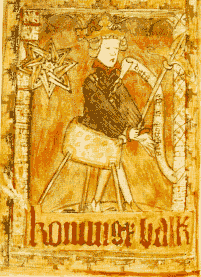Meet the Middle Ages
BackMagnus Eriksson

Magnus Eriksson (1316-1374) is the King with the longest reign in Nordic history. For 33 years, he ruled Sweden and Norway. Before that, he had been the under-aged King of the two countries for 12 years.
Magnus Eriksson was the son of Duke Erik Magnusson and the Norwegian princess Ingeborg Haakonsdotter. At the age of two, he, in 1318, he succeeded his grandfather as King of Norway. Next year, he was elected King of Sweden. In 1331, when he was 15, he was old enough to rule.
Magnus went all the way to Namur in France to find a wife. He returned home with the beautiful Blanche. As a lady-in-waiting at the French court, she was used to elegance and luxury. She tried to introduce a refined life-style in Sweden as well. Magnus and Blanche had five children, three daughters and two sons.
Magnus Eriksson tried to update Swedish society. He abolished slavery in 1335. In the middle of the 14th century, he replaced the old provincial laws with a common law for the entire country. A few years later, he established a town-law for Stockholm, which was applied in all the Swedish towns. King Magnus pursued an active foreign policy. In 1332, he bought the provinces of Skåne and Blekinge. He led two crusades to Novgorod (in 1348 and in 1350) in order to gain control over the trade there.
King Magnus became increasingly powerful, which angered and provoked the aristocracy. Birgitta Birgersdotter (St, Birgitta) in particular, repeatedly showed her discontent with him. It is obvious in her revelations. Finally, the noblemen rebelled against Magnus. In 1364, he lost the throne, and Albrekt of Mecklenburg was elected King. Magnus was imprisoned and had to leave for Norway, where his son was King. Magnus Eriksson died at sea. He drowned when he fell overboard during a severe storm off the Norwegian coast in 1374.